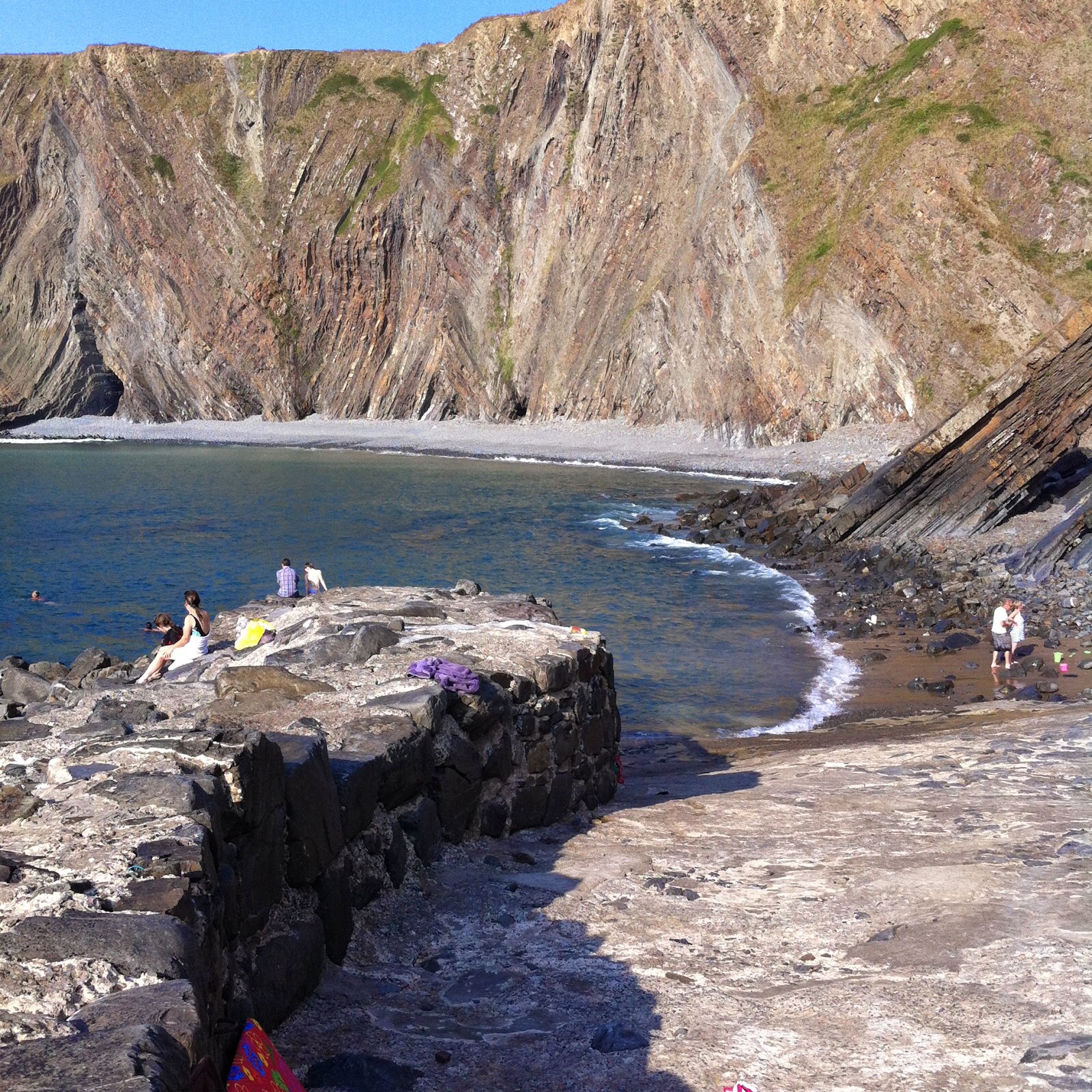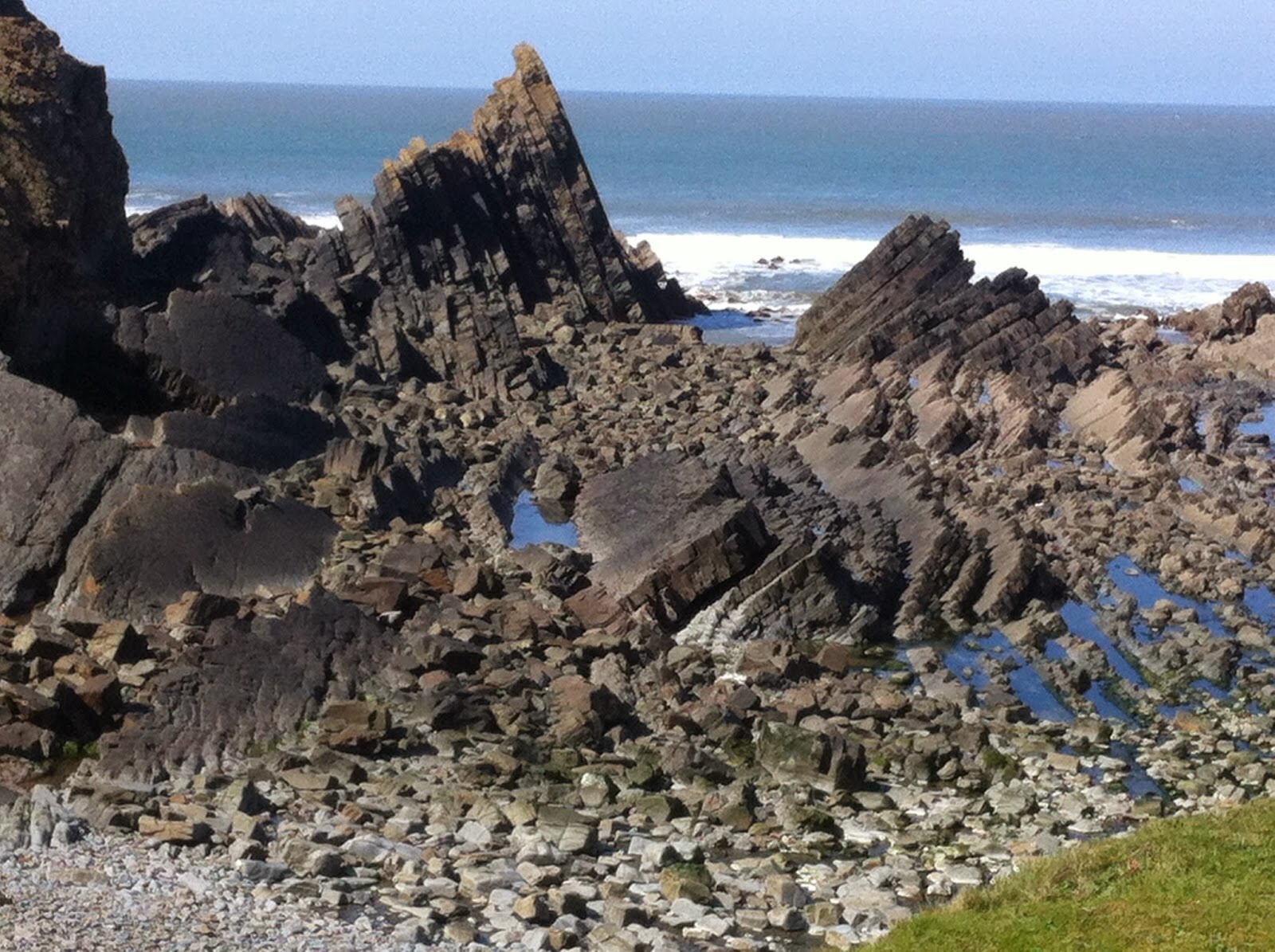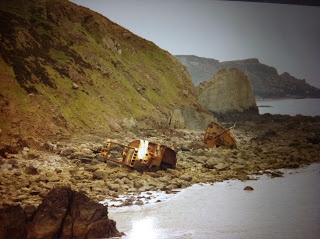This info comes from a slender pamphlet called “Farthest From Railways: An Unknown Corner of Devon” by R. Pearse Chope, originally written in 1934.
It seems Hartland Parish, despite being one of the largest in Devon, amounting to 17,000 acres in size, is too hilly for a cricket ground, is bounded by the Atlantic (already knew that bit) and is separated from other parishes by steep valleys. It is a place with its own very real characteristics. As someone once said to me: “you live in Hartland, do you? That’s God’s own country up there”. That said, it’s only around an hour and a half (unless you travel by broomstick) from the M5, so civilisation is really not SO far away … which especially attracts visitors from the M4/M5 corridor.

Vis-a-vis railways, the place Chope is talking about is, of course, Hartland Point, site of the lighthouse which has become something of a symbol for the area:“When you have sought all England round, Farthest from railways this will be found”.
Of course, in Chope’s pre-Beeching days, we had railways stations at the equidistant, but very different towns of Bude in Cornwall and Bideford in Devon, which were both closed when the unfortunate axe fell. What a sad legacy Beeching left. The late Bryan Dudley Stamp, a local historian from Bude, told me with a sense of relish of the wonderful journeys he used to have travelling by train from Bude to London, complete with fabulously civilised dining facilities. It may be considered progress but having no trains nearby strikes me as a backward move and one which should be reversed. To pop to Bude and catch a train to Paddington would be a delight, especially a steam train, but any train would do. Driving to Tiverton Parkway is somewhat less enticing, but happens. Meanwhile, it’s a car or bus to Hartland unless you walk it.
Yet, it is the geographical distance from the main conurbations that give the Hartland Peninsula its undoubted charm, a chance to step away from the stresses of everyday life, a sense of peace and tranquillity securely nestled between those high North Devon hedges, with views to Lundy, over farmland, moors and heath, past streams flowing out to sea.

Chope perhaps waxed rather more lyrically than we would today, but the upshot of his pamphlet is that Hartland is off the beaten track, it: “is still an almost unknown country, although its scenery is more beautiful and its history more interesting than any other place in North Devon”. Praise indeed, for Chope even claims that Hartland is superior to the very popular (and beautiful) Clovelly and Lynmouth areas, because of the wonderful variety of its scenery, ranging from wooded cliffs and wild rocks to wind-swept moorland and secluded vales … I have visited all of them and feel Hartland is more authentic, less-contrived.
I must accede that Hartland is a small place which is largely cut off from other areas but it is that splendid isolation which provides its unique character. People visit the area for many reasons. Some come for a family holiday, others for total rest and relaxation, some because it is romantic, many for reasons of tranquillity, and yet others recovering from illness, in need of peace and quiet, or escaping busy lives (the erratic mobile signal around these parts is a great help at such times!) Some even come here to work, to start that novel, learn a new skill, to have a family get-together or simply to see some spectacular sights and to reflect. And of course, Prince William came here for his stag party, a new tradition which led to many adventurous surfing and coasteering ‘hens’ and ‘stags’, especially among young professionals and those more mature in age/nature, seeking an adrenaline rush.

The Genuki website perhaps unfairly describes Hartland as “a small, decayed market town” and writes of “this bleak parish….bounded on the south by some boggy heights”. A place is what you make of it, and how much you enjoy the area partly depends on whether you are a glass half full or half empty person. Yes, it gets muddy and yes, it struggles economically but it also has some wonderful facilities and vistas for holidaymakers and visitors. Now, for locals, the Resurgence Centre, previously The Small School, has opened up classes and talks, and 2020 sees the start of Hartland Book Festival.
Chope also mentions Lundy, as he really must, because of its omnipresence from the Peninsula. It is readily seen from Hartland’s coastline and higher ground, with its own famous weather forecast:
“Lundy high, sign of dry; Lundy plain, sign of rain; Lundy low, sign of snow.”
The view towards Lundy from Bursdon Moor is one I found breathtakingly beautiful when I first moved here and, even now, it still makes me stop and wonder for it is super-awesome. Every day, Lundy looks different depending upon the weather. Sometimes, it disappears altogether. There’s something magical about the sight of Lundy, especially when shrouded in sea mist. It could almost be Arthurian Avalon. On other days, it looks close and clear enough to swim to, which of course has been done (it’s difficult) but not by me!

Hartland is separated from its neighbouring parishes of Clovelly and Welcombe and is thus, as Chope suggests “on the road to nowhere” which reminds me of an old Talking Heads song. In some ways, the A39 Atlantic Highway from the North Devon Link Road to Bude and beyond does Hartland a disservice by helping people to drive straight past it, despite the brown tourism signs highlighting the local attractions like Hartland Abbey, and the artisans’ activities, such as the numerous potteries.
Chope also complained that “on all sides, tourists are told that there is nothing to be seen there,” a comment I have heard made by tourists looking for something more along the lines of what Newquay has to offer. Certainly, it is not the place for clubbers! This is why the volunteer-led Hartland Peninsula Association originated, to promote tourism in this little-known jewel, but in a sustainable way which would not detract from its astonishingly rare beauty. To those who say there is nothing to see here, I say: “try looking up” for we have the most amazing sunsets and sunrises, plus regular blankets of stars to light our way, and that’s without even veering near to the incredible coastline.

However, there are still people to whom the area is largely unknown, distant and a little mystical. For walkers, however, it embraces the at times strenuous South West Coast Path, in itself a magnificent attraction, and offers some beautiful sights, such as carpets of spring bluebells, snowdrops and daffodils at Hartland Abbey. We used to visit Cornwall and Devon regularly, even before we had children; our first holiday with our eldest daughter was in fact in a cottage at nearby Eastcott, just over the Cornish border near Morwenstow, from where we visited Hartland Quay and Hartland Point (when you could actually reach the lighthouse) among other places. Funny how we have now come to roost here, along with the vocal wood pigeon outside who serenades us on a regular basis, or at nighttime the male tawny owl. Chaffinches and bluetits clamour to the bird table, co-existing peacefully with collared-doves and even starlings.
There is a dark side to such rugged beauty, of course, which is, historically, the number of wrecks found in the area; the remains of the Johanna still haunt Hartland Point. It has not been called the ‘Wreckers Coast’ for nothing, for the coast here, lashing against the rocks, takes no prisoners. The lighthouse reduced the number of these (and satnav will presumably continue to do so) but the local proverb still rings true when you see the sea lashing against the rocks at the Quay during a storm:
“From Padstow Port to Lundy Light/Is a watery grave by day or night”.

There were 35 wrecks off the coast here between 1862 and 1904, the largest of which was an Italian steamship, the Rosalia, totally wrecked in very thick fog at Hartland Quay on 27th May 1904. Local people used to loot the wrecks, understandably, but the most notorious wrecker of legend has been claimed by both Devon and Cornwall, seemingly a Danish sailor known as Cruel Coppinger. In 1866, the Reverend Stephen Hawker of nearby Morwenstow wrote of him:
Will you hear of Cruel CoppingerHe came from a foreign land; He was brought to us by the saltwater,He was carried away by the wind! which refers to Coppinger’s disappearing act when chased by the Revenue men.

The coast is indeed spectacularly dangerous, but conversely, hauntingly beautiful, inspirational to writers, artist and photographers alike. The coastal waterfall at Speke’s (Spekes Mill is a series of coastal waterfalls, with the first fall nearly 54ft high) and the awesome rock formations framing the Quay which were even mentioned by Charles Kingsley, writer of The Water Babies and Westward Ho!: “There must have been strange work here , when all these strata were being pressed and squeezed together like a ream of wet paper between the rival granite pincers of Dartmoor and Lundy”.
They are indeed breathtaking or, as Chope says, they “baffle description completely”. Sadly, the iconic Hartland Point lighthouse was put on the market, so its future is uncertain. It was erected in 1874 as a remarkable piece of engineering (for, Chope tells us, the surveyor couldn’t get anywhere near the site and had to make observations and measurements from a ship at sea) and will hopefully be allowed to maintain its character, which is so vital to the Hartland Peninsula identity.

Hartland has existed for a long time if one accepts Chope’s interpretation of history. Apparently, the Hercules Promontory identified by Ptolemy has been identified as Hartland Point. The names around here are interesting, too. Heard is one such well established local name. It is likely to have come from the Heort clan, derived from the Saxon settlement of Heortings, which led to the names Harton and later Hartland. You won’t go anywhere without encountering a Heard.
Chope writes at length about St Nectan and the church at Stoke hamlet, two miles from Hartland, itself a fascinating building with a huge history, but he also mentions the town of Hartland itself. Formerly a borough, it held weekly markets and two annual fairs, from about 1280 onwards. A granite cross was built as a war memorial in the square, as close as possible to the site of the old market cross. The old town clock was made into a pendulum clock by John Morcombe of Barnstaple in 1657- 8 at a cost of £1. The space beneath the hall was used as a market-house with shambles for butchers and stands for hatters, glovers and tanners. Malting, cheese-making, brewing and cider-making were also locally produced. You can imagine a veritable hive of activity here in its heyday. Now, it is a sleepy village, still seasidey with its coloured houses, and a hive of activity in the workshops, though these are all behind the scenes.
The town also had stocks, plus a cucking-stool for punishing women with a dunking and the associated ritual humiliation. This was especially used for offences which were sexual in nature or involved scolding/gossiping. Not sure the men ever suffered it! Bull-baiting was also provided as a bit of entertainment once or twice a year, with cock-fighting more regularly and maypole games, all community-based activities even if some of them are to twenty-first-century eyes barbaric. Something of a den of iniquity was old Hartland or Harton, and you can read more about the history as you try a historic walk.

Hartland also enjoys a military history, for it was assumed by many that the French would land at Blackpool Mill during the Napoleonic Wars, a place which has been used more recently for the filming of Sense and Sensibility. An effigy of the hated Napoleon was said to have been chained to one of the devil and set up on Hartland Point. It is said that “on the very day Napoleon escaped from Elba, a great storm arose and swept his effigy into the sea”. There’s always a tale to be told here …

